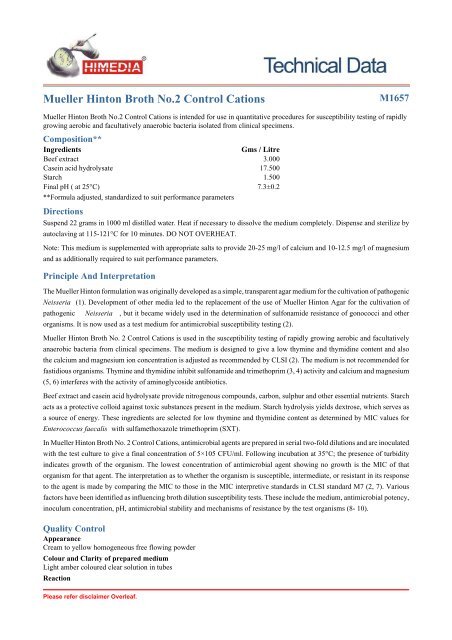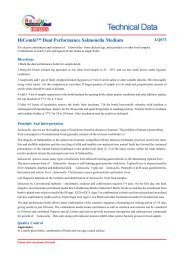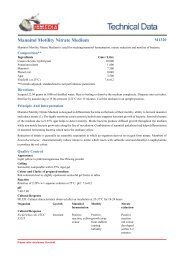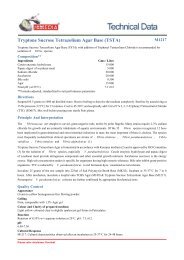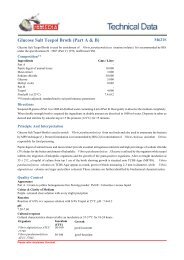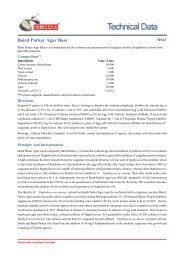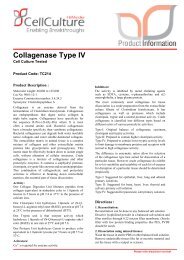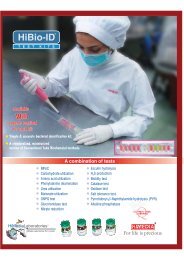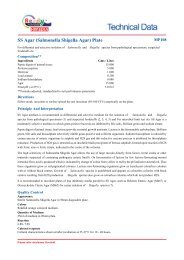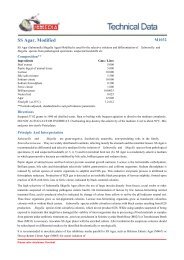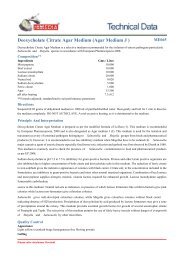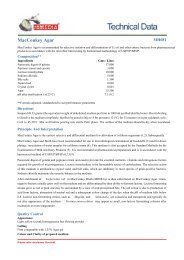Mueller Hinton Broth No.2 Control Cations - HiMedia Laboratories
Mueller Hinton Broth No.2 Control Cations - HiMedia Laboratories
Mueller Hinton Broth No.2 Control Cations - HiMedia Laboratories
You also want an ePaper? Increase the reach of your titles
YUMPU automatically turns print PDFs into web optimized ePapers that Google loves.
<strong>Mueller</strong> <strong>Hinton</strong> <strong>Broth</strong> <strong>No.2</strong> <strong>Control</strong> <strong>Cations</strong><br />
Please refer disclaimer Overleaf.<br />
M1657<br />
<strong>Mueller</strong> <strong>Hinton</strong> <strong>Broth</strong> <strong>No.2</strong> <strong>Control</strong> <strong>Cations</strong> is intended for use in quantitative procedures for susceptibility testing of rapidly<br />
growing aerobic and facultatively anaerobic bacteria isolated from clinical specimens.<br />
Composition**<br />
Ingredients Gms / Litre<br />
Beef extract 3.000<br />
Casein acid hydrolysate 17.500<br />
Starch 1.500<br />
Final pH ( at 25°C) 7.3±0.2<br />
**Formula adjusted, standardized to suit performance parameters<br />
Directions<br />
Suspend 22 grams in 1000 ml distilled water. Heat if necessary to dissolve the medium completely. Dispense and sterilize by<br />
autoclaving at 115-121°C for 10 minutes. DO NOT OVERHEAT.<br />
Note: This medium is supplemented with appropriate salts to provide 20-25 mg/l of calcium and 10-12.5 mg/l of magnesium<br />
and as additionally required to suit performance parameters.<br />
Principle And Interpretation<br />
The <strong>Mueller</strong> <strong>Hinton</strong> formulation was originally developed as a simple, transparent agar medium for the cultivation of pathogenic<br />
Neisseria (1). Development of other media led to the replacement of the use of <strong>Mueller</strong> <strong>Hinton</strong> Agar for the cultivation of<br />
pathogenic Neisseria , but it became widely used in the determination of sulfonamide resistance of gonococci and other<br />
organisms. It is now used as a test medium for antimicrobial susceptibility testing (2).<br />
<strong>Mueller</strong> <strong>Hinton</strong> <strong>Broth</strong> No. 2 <strong>Control</strong> <strong>Cations</strong> is used in the susceptibility testing of rapidly growing aerobic and facultatively<br />
anaerobic bacteria from clinical specimens. The medium is designed to give a low thymine and thymidine content and also<br />
the calcium and magnesium ion concentration is adjusted as recommended by CLSI (2). The medium is not recommended for<br />
fastidious organisms. Thymine and thymidine inhibit sulfonamide and trimethoprim (3, 4) activity and calcium and magnesium<br />
(5, 6) interferes with the activity of aminoglycoside antibiotics.<br />
Beef extract and casein acid hydrolysate provide nitrogenous compounds, carbon, sulphur and other essential nutrients. Starch<br />
acts as a protective colloid against toxic substances present in the medium. Starch hydrolysis yields dextrose, which serves as<br />
a source of energy. These ingredients are selected for low thymine and thymidine content as determined by MIC values for<br />
Enterococcus faecalis with sulfamethoxazole trimethoprim (SXT).<br />
In <strong>Mueller</strong> <strong>Hinton</strong> <strong>Broth</strong> No. 2 <strong>Control</strong> <strong>Cations</strong>, antimicrobial agents are prepared in serial two-fold dilutions and are inoculated<br />
with the test culture to give a final concentration of 5×105 CFU/ml. Following incubation at 35°C; the presence of turbidity<br />
indicates growth of the organism. The lowest concentration of antimicrobial agent showing no growth is the MIC of that<br />
organism for that agent. The interpretation as to whether the organism is susceptible, intermediate, or resistant in its response<br />
to the agent is made by comparing the MIC to those in the MIC interpretive standards in CLSI standard M7 (2, 7). Various<br />
factors have been identified as influencing broth dilution susceptibility tests. These include the medium, antimicrobial potency,<br />
inoculum concentration, pH, antimicrobial stability and mechanisms of resistance by the test organisms (8- 10).<br />
Quality <strong>Control</strong><br />
Appearance<br />
Cream to yellow homogeneous free flowing powder<br />
Colour and Clarity of prepared medium<br />
Light amber coloured clear solution in tubes<br />
Reaction
<strong>HiMedia</strong> <strong>Laboratories</strong> Technical Data<br />
Reaction of 2.2% w/v aqueous solution at 25°C. pH : 7.3±0.2<br />
pH<br />
7.10-7.50<br />
Cultural Response<br />
M1657: Cultural characteristics observed after an incubation at 35 - 37°C for 18 - 24 hours .<br />
Organism Inoculum<br />
(CFU)<br />
Disclaimer :<br />
Growth<br />
Escherichia coli ATCC<br />
25922<br />
50-100 good-luxuriant<br />
Pseudomonas aeruginosa<br />
ATCC 27853<br />
50-100 good-luxuriant<br />
Staphylococcus aureus<br />
ATCC 25923<br />
50-100 good-luxuriant<br />
Enterococcus faecalis ATCC 50-100<br />
29212<br />
good-luxuriant<br />
Storage and Shelf Life<br />
Store below 30°C in tightly closed container and the prepared medium at 2 - 8°C. Use before expiry date on the label.<br />
Reference<br />
1. <strong>Mueller</strong> and <strong>Hinton</strong>. 1941. Proc. Soc. Exp. Biol. Med. 48:330.<br />
2. National Committee for Clinical Laboratory Standards. 2000. Approved Standard: M7-A5. Methods for dilution<br />
antimicrobial susceptibility tests for bacteria that grow aerobically, 5th ed. NCCLS, Wayne, Pa.<br />
3. Koch A. E. and Burchall J. J., 1971, Appl. Microbiol., 22: 812<br />
4. Ferone R. Bushby R. M., Burchall J. J., Moore W. D., Smith D., 1975, Antimicrob. Agents chemotherap., 7 : 91<br />
5. Pollock H. M., Minshew B. H., Kenney M. A., Schoenknecht F. D., 1978, Antimicrob. Agents Chemotherap.; 14:360<br />
6. DAmato R. F., and Thornsberry C., 1979, Curr. Microbiol., 2 : 135<br />
7. National Committee for Clinical Laboratory Standards, 2002, Performance Standards for antimicrobial susceptibility testing;<br />
12th Informational Supplement, M100-S12(M7). NCCLS, Wayne, Pa.<br />
8. Murray P. R., Baron J. H., Pfaller M. A., Jorgensen J. H. and Yolken R. H., (Ed.), 2003, Manual of Clinical Microbiology,<br />
8th Ed., American Society for Microbiology, Washington, D.C.<br />
9. Ericsson H. M. and Sherris J. L., 1971, Acta Pathol. Microbiol., Scand. Sect B Suppl., 217:1.<br />
10. Thornsberry C., Gavan T. L. and Gerlach E. H., 1977, Cumitech 6, New developments in antimicrobial agent susceptibility<br />
testing. Coord. Ed., Sherris. American Society for Microbiology, Washington, D.C.,,<br />
Revision : 1 / 2011<br />
User must ensure suitability of the product(s) in their application prior to use. Products conform solely to the information contained in this<br />
and other related <strong>HiMedia</strong> publications. The information contained in this publication is based on our research and development work<br />
and is to the best of our knowledge true and accurate. <strong>HiMedia</strong> <strong>Laboratories</strong> Pvt Ltd reserves the right to make changes to specifications<br />
and information related to the products at any time. Products are not intended for human or animal diagnostic or therapeutic use but for<br />
laboratory, research or further manufacturing use only, unless otherwise specified. Statements contained herein should not be considered<br />
as a warranty of any kind, expressed or implied, and no liability is accepted for infringement of any patents.<br />
<strong>HiMedia</strong> <strong>Laboratories</strong> Pvt. Ltd. A-516,Swastik Disha Business Park,Via Vadhani Ind. Est., LBS Marg, Mumbai-400086, India. Customer care No.: 022-6147<br />
1919 Email: techhelp@himedialabs.com


